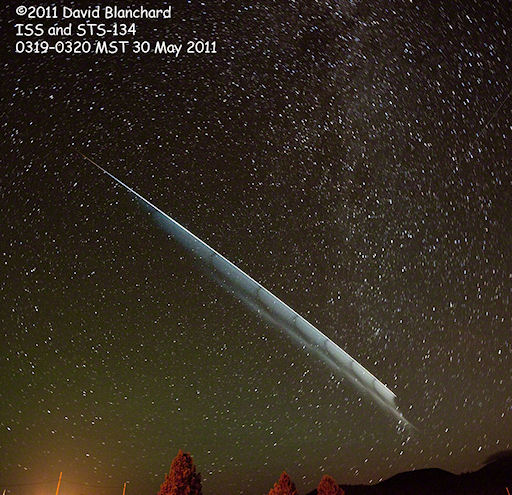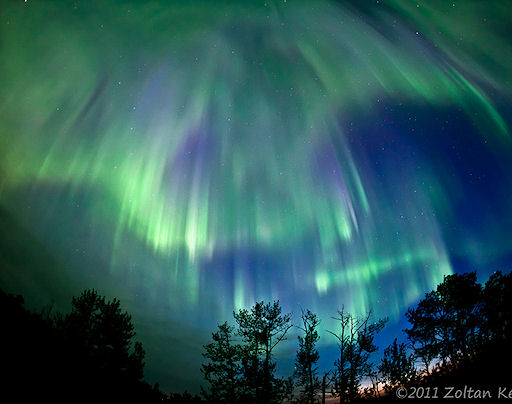DOUBLE FLYBY ALERT: Space shuttle Endeavour undocked from the International Space Station at 11:55 pm EDT on May 29th. This sets the stage for a series of beautiful double flybys: The shuttle and station will soar through the night sky side-by-side in advance of Endeavour's final landing on June 1st. Check theSimple Satellite Tracker or your cell phone to see if you are favored with an apparition.
"Early this morning, I witnessed a spectacular double flyby of the ISS and Endeavour over northern Arizona," reports David Blanchard of Flagstaff, Arizona. "As the two spacecraft moved out of Earth's shadow I noted a fuzzy cloud below their track. It wasn't long before I realized that Endeavour was venting its tanks creating an ice cloud in space that was moving along with the two craft." (continued below)
Photo details: Nikon D700; ISO 3200; f/4; 16-35mm@16; 15s.
"Endeavour had just undocked a few hours earlier and was following very closely behind the ISS," continues Blanchard. "It had not yet modified its orbit substantially so that its track nearly matched that of the ISS, and it is difficult to distinguish the two tracks in this image. Also visible in the upper right is the faint track of another earth orbiting satellite -- most likely COSMOS 2228."
More Images: from Marsha Adams of Sedona, Arizona; from Bob Thompson of Prescott, Arizona; from Mark A. Brown of Carlisle, PA; from Paul M. Hadfield of Decatur, IL; from Achim Schaller of Freiburg, Southern Rhine Valley, Germany; from Terry Mann of West Manchester, Ohio; from Catalin Fus of Krakow, Poland; from Mark Staples of Lake Santa Fe, Waldo, FL;
WEEKEND AURORAS: A solar wind stream hit Earth's magnetic field on May 28th, sparking a G2-class geomagnetic storm and bright auroras at high latitudes. "In the Alberta prairies east of Edmonton, it looked like it was raining auroras," reports photographer Zoltan Kenwell. "Blues, purples, and greens were all over the place." (continued below)
"It was a fantastic display!" he says.
Both ends of the Earth were affected. People saw auroras in Tasmania, New Zealand, Antarctica, Wisconsin and Minnesota. The solar wind is still blowing strong on May 30th, prompting NOAA forecasters to estimate a 35% chance of more geomagnetic activity in the next 24 hours. Now might be a good time to sign up foraurora alerts: text, voice.
More Images: from Brian Larmay of Pembine, Wisconsin; from Minoru Yoneto of Queenstown, New Zealand; from Neva Andersen of Saint Cloud, Minnesota; from Dave Curtis of Dunedin, New Zealand; from Ian Stewart of Hobart, Tasmania, Australia; from Tom Luttrell of Mount Nelson Signal Station, Hobart, Tasmania; from Beatrice van Eden of Antarctica.
Provided by Space Weather News

